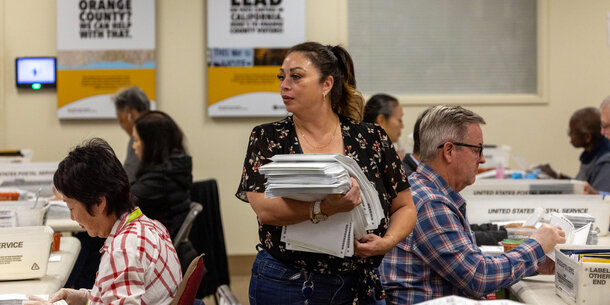The slow pace of counting mail ballots in states such as Pennsylvania, Michigan, and Wisconsin was a key source of election disinformation in 2020. The delays provided President Trump and his allies with a pretext to claim that the election was being stolen from them as mail ballots, which overwhelmingly went for Biden, were counted and added to vote totals. “We were winning everything, and all of a sudden it was just called off,” Trump complained. “This is a fraud on the American public.”
Far from being a fraud, a conspiracy, or even an accident, the slow count of mail ballots is a deliberate choice that lawmakers in key battleground states have made — and with disastrous consequences for public trust in elections. By building these delays into the system, lawmakers give oxygen to false claims of “ballot dumps” and other nonsense that has been used to sow distrust and has led to threats and violence against election workers. We will hear the same false claims after the 2022 election — in which mail ballots again appear to be tilting Democratic — and in every subsequent election until state legislatures fix the process.
State law prescribes the timing of the vote-counting process. Most states allow election workers to remove ballots from their envelopes and confirm the voter’s eligibility before Election Day, sometimes weeks in advance as the ballots arrive at processing centers. Nearly half of states — including Florida, Ohio, and Texas — allow election officials to scan ballots into tabulators ahead of Election Day so that these ballots can be counted immediately and included in results on election night. (No state allows results to be released before then.)
The process is drastically different in a minority of states, including key election battlegrounds such as Michigan, Pennsylvania, and Wisconsin. In those states, election workers are, with few exceptions, prohibited from opening mail ballots before Election Day. Election officials in these states have begged their state legislatures for increased flexibility over the past few years and have been repeatedly rebuffed, including by many legislators who criticized slow counting in 2020 or backed claims that the vote count showed evidence of fraud. Only in Michigan did some cities successfully convince their legislature to allow any processing before Election Day. But even in those rare cases, the time permitted is far less than election officials asked for (just two days before Election Day), and the change came too late for many cities to implement it by the 2022 election. As a result of these legislative failures, state officials in each of these three states are warning voters that counting may go on for at least a day or two after polls close.
As in 2020, the media has done an excellent job of explaining that results won’t be final on election night, and voters should be prepared for counts to change in the following days. But as long as there are election deniers running for office, delays in counting ballots will be used to seed conspiracy theories and spread lies about the trustworthiness of the election process. Indeed, a top reason given by voters who doubt the outcome of the 2020 election is that the results seemed to change after election night. (“When I went to bed, Trump was so in the lead, and then (I got) up and he’s not in the lead. I mean, that’s crazy,” one Georgia voter recalled.)
Political leaders in these battleground states know that the whole country will be watching them once again in 2022. Given this, and how clearly election officials have expressed their need for more time to process and scan ballots, the lack of legislative action in several states appears likely to facilitate more chaos and disinformation as election workers try to do their jobs, in turn spurring more threats and attacks on these workers.
To be sure, in particularly close elections, it may take days or even weeks before a winner can be declared, regardless of when a state begins to process mail ballots. And accuracy should always be prioritized above speed. But if, as expected, there are more false claims of rigged elections and more threats of violence because of delays caused by election officials being forced to wait until Election Day to process mail ballots, much of the blame should fall on the state legislators who failed to address a known source of conspiracy theories, not the election workers who labor tirelessly within their given authority to ensure a secure and accurate vote count.




